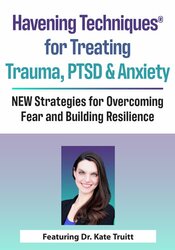Reduce Anxiety with Self-Havening Touch & Breathwork
A powerful partnership for calming the brain and body

What can you do when your client is hijacked by their emotional brain? When no amount of talking and thinking will unwind their cycling thoughts and ruminations?
I’d like to introduce you to a tool called CPR for the amygdala. CPR stands for Creating Personal Resiliency.
The following exercise uses soothing self-havening touch and breathwork to support clients in releasing any activating moments or triggers that have been causing them difficulty or have been intruding into their minds.
Self-havening touch soothes the autonomic nervous system by generating a slow brainwave state and releasing soothing neurochemicals in the brain (GABA, serotonin, oxytocin, etc.). Pairing this havening touch with breathwork creates even more calm in the mind and body by activating the parasympathetic nervous system – the body’s brake pedal.
When clients focus their attention on the counts of each breath, it also redirects their thought process from whatever was bothering them, allowing their minds and bodies to calm down more effectively.
To Perform The Self-Havening Touch
- Cross your arms across your chest and rest your fingertips on the top of your shoulders, then move your hands down your arms to your elbows, like a moving hug.
- Alternatively, you can also use palm havening. Pretend you’re washing your hands and rub the palms of your hands together slowly.
- Repeat these motions throughout the following exercise to calm and soothe the brain and body.
To Perform CPR for the Amygdala
- Invite your client to identify the experience, emotion, or thought that is causing them distress, (noting what they can see, hear, smell, taste, and feel) and rate it on a distress scale of 0 to 10.
- Ask them to begin applying the self-havening touch and continue it while you guide them in a series of deep breaths. It is best to vocalize the breath counts aloud for the client to help them slow their breathing and provide a focus for their attention.
- Start with a slow inhale to a count of 3 and exhale to a count of 5. Gradually begin lengthening the breath with an inhale to 4 and an exhale to 6, then and inhale to 5 and exhale to 7. Next, gradually begin reducing the length of the breath with an inhale to 4 and an exhale to 6, then a slow inhale to a count of 3 and exhale to a count of 5.
- Invite your client to let their hands rest and check back in with the event, emotion, or thought they identified at the beginning and rate it again on the distress scale of 0 to 10. If they are at a 2 or below, wonderful! If not, repeat the tool again.
This is also a wonderful tool to teach clients to use on their own between sessions whenever they are experiencing distress. Doing so builds agency and empowerment as they build the ability to care for themselves effectively!
Any time clients practice CPR for the amygdala, they are creating their own resilience and making it less likely that the amygdala will have the ability to show up and take over their emotional world in the future.

Wouldn’t it be great having highly effective easy-to-use tools that directly address the emotions keeping your clients stuck in painful pasts and unable to realize a brighter future?
Utilizing similar mechanisms as Eye Movement Desensitization and Reprocessing (EMDR), Havening Techniques are a new suite of neuroscience-based interventions designed for fast and effective treatment of posttraumatic stress disorder and other fear-based disorders such as anxiety, panic disorder, and phobias – whether your clients are in session, at home or on the go – whenever difficult emotions come at unexpected times!
Join Havening Techniques Certified Trainer and Global Director of Continuing Education, Dr. Kate Truitt, for this must-see webcast and discover her secrets for creating a gentle, clientcentered approach to trauma-informed, neuroscience-based, and resiliency-focused care.
Dr. Truitt knows that when we choose to let every moment of adversity strengthen and empower us, we are choosing to be our strongest and most empowered selves. Her treatment model consists of three core pillars: trauma informed, neuroscience based, and resiliency focused care, which empowers clinicians to become proactive guides in the client's transformational journeys as they seek and obtain their fulfilled life.
Learn more about their educational products, including upcoming live seminars, by clicking here.
Topic: Havening | Posttraumatic Stress Disorder (PTSD) | Trauma
Tags: Breath | How To | Posttraumatic Stress Disorder (PTSD) | Strategies | Success | Therapy Tools | Tools | Trauma | Video | Wisdom





